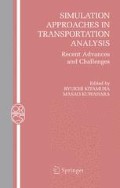Abstract
In order to evaluate ITS options and dynamic TDM options, it has become important to understand how to integrate traffic simulations and dynamic travel behaviour choice models. Although Traffic simulation is well organised, visual and understandable, it looks weak in regards to representing user behaviour. From the standpoint of travel behaviour analysis, this paper points out the consistency problems and specific points in the integration of traffic simulation and dynamic route choice model or dynamic time-of-day choice model. It is recommended that fundamental concepts, such as choice set and user segmentation be incorporated appropriately into traffic simulations.
Access this chapter
Tax calculation will be finalised at checkout
Purchases are for personal use only
Preview
Unable to display preview. Download preview PDF.
References
Harata, N, Morikkawa, T, and Yai, T. (1993). Review and Perspective of Travel Behavior Analysis Focusing On Disaggregate Travel Demand Models, Journal of Infrastructure Planning and Management, No.470, IV-20, pp97–104 (in Japanese).
i-Transport Lab. (2001). Manual of SOUND/A-21 (in Japanese).
L.D. Burns. (1979). Transportation, Temporal, and Spatial Components of Accessibility, Lexington Books.
Maruyama, T., Harata, N. and Ohta, K. (2002). Application of combined network equilibrium model to mega metropolitan area, Infrastructure Planning Review, Vol.19 (in Japanese).
Moshe. Ben-Akiva and Steven R. Lerman. (1985). Discrete Choice Analysis, The MIT Press.
Oneyama, H., IRYO, T. and Kuwahara, M. (2001). Simulation analysis of traffic congestion alleviation and environmental improvement by demand spreading over time in Tokyo Metropolitan area, The Proceedings of the Infrastructure Planning Review Annual Meeting, 24 (in Japanese).
P.H.L. Bovy., E. Stern. (1990). Route Choice: Wayfindings in Transport Networks, Kluwer Academic Publishers, pp309.
TDM study group. (2002). Successful Park and Ride, Japan Society of Traffic Engineers (In Japanese).
Yoshii, T. (1999). Development and application of dynamic assignment simulation model applicable to a large-scale network, p.178, Doctor of Engineering Thesis, University of Tokyo (in Japanese).
Author information
Authors and Affiliations
Editor information
Editors and Affiliations
Rights and permissions
Copyright information
© 2005 Springer Science+Business Media, Inc.
About this chapter
Cite this chapter
Harata, N. (2005). Consistency of Traffic Simulation and Travel Behaviour Choice Theory. In: Kitamura, R., Kuwahara, M. (eds) Simulation Approaches in Transportation Analysis. Operations Research/Computer Science Interfaces Series, vol 31. Springer, Boston, MA. https://doi.org/10.1007/0-387-24109-4_12
Download citation
DOI: https://doi.org/10.1007/0-387-24109-4_12
Publisher Name: Springer, Boston, MA
Print ISBN: 978-0-387-24108-1
Online ISBN: 978-0-387-24109-8
eBook Packages: Business and EconomicsEconomics and Finance (R0)

